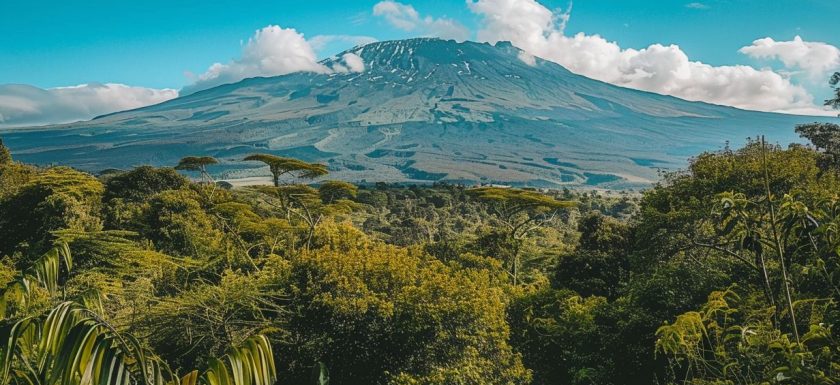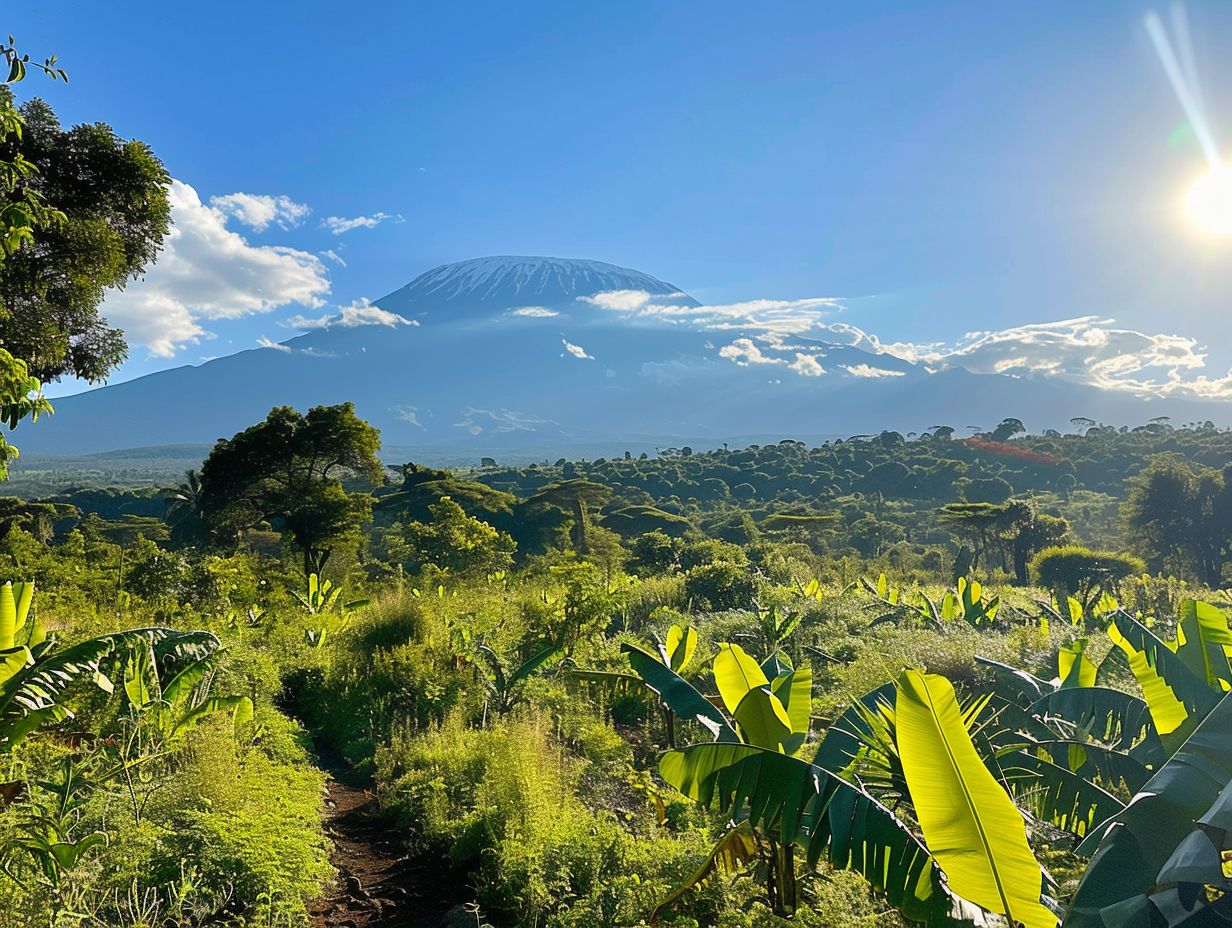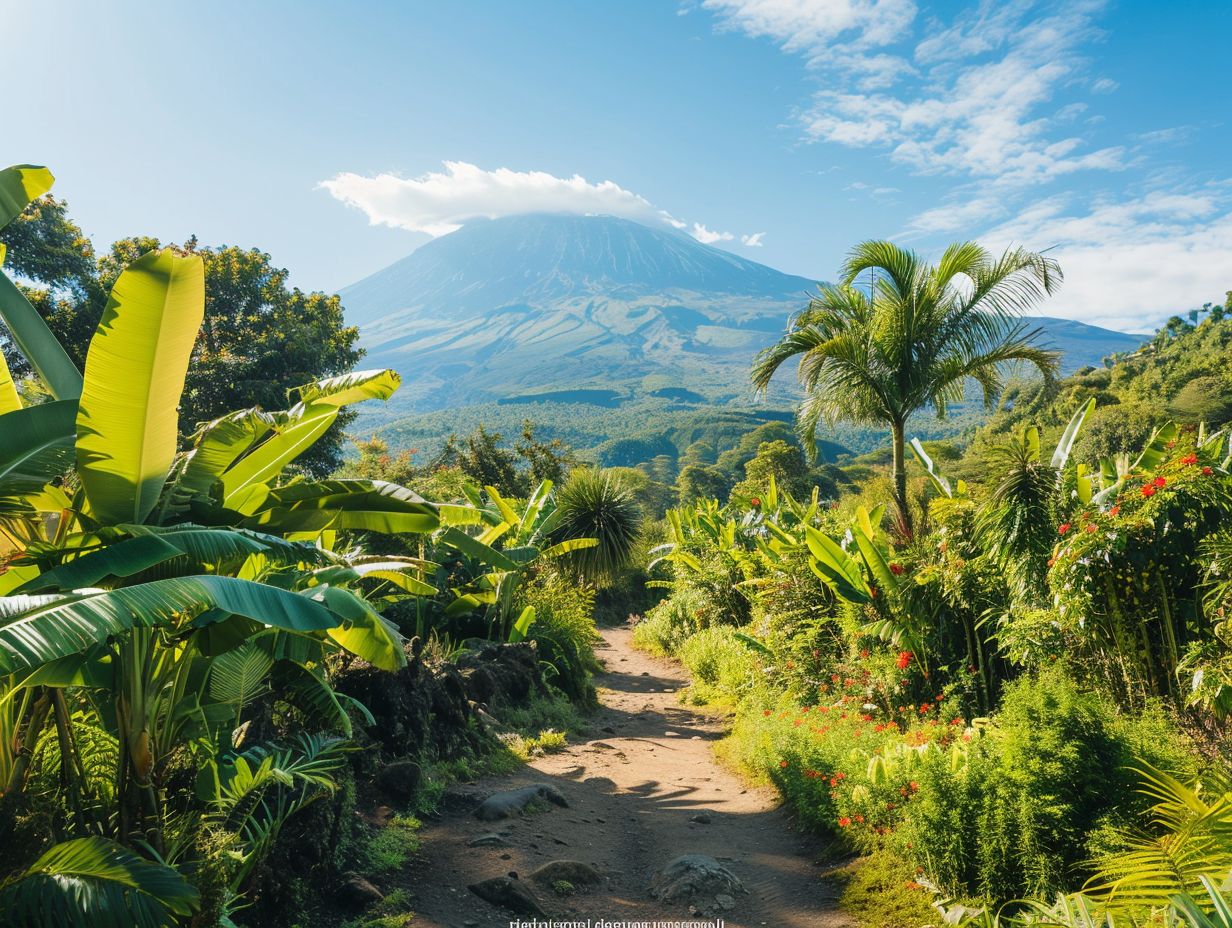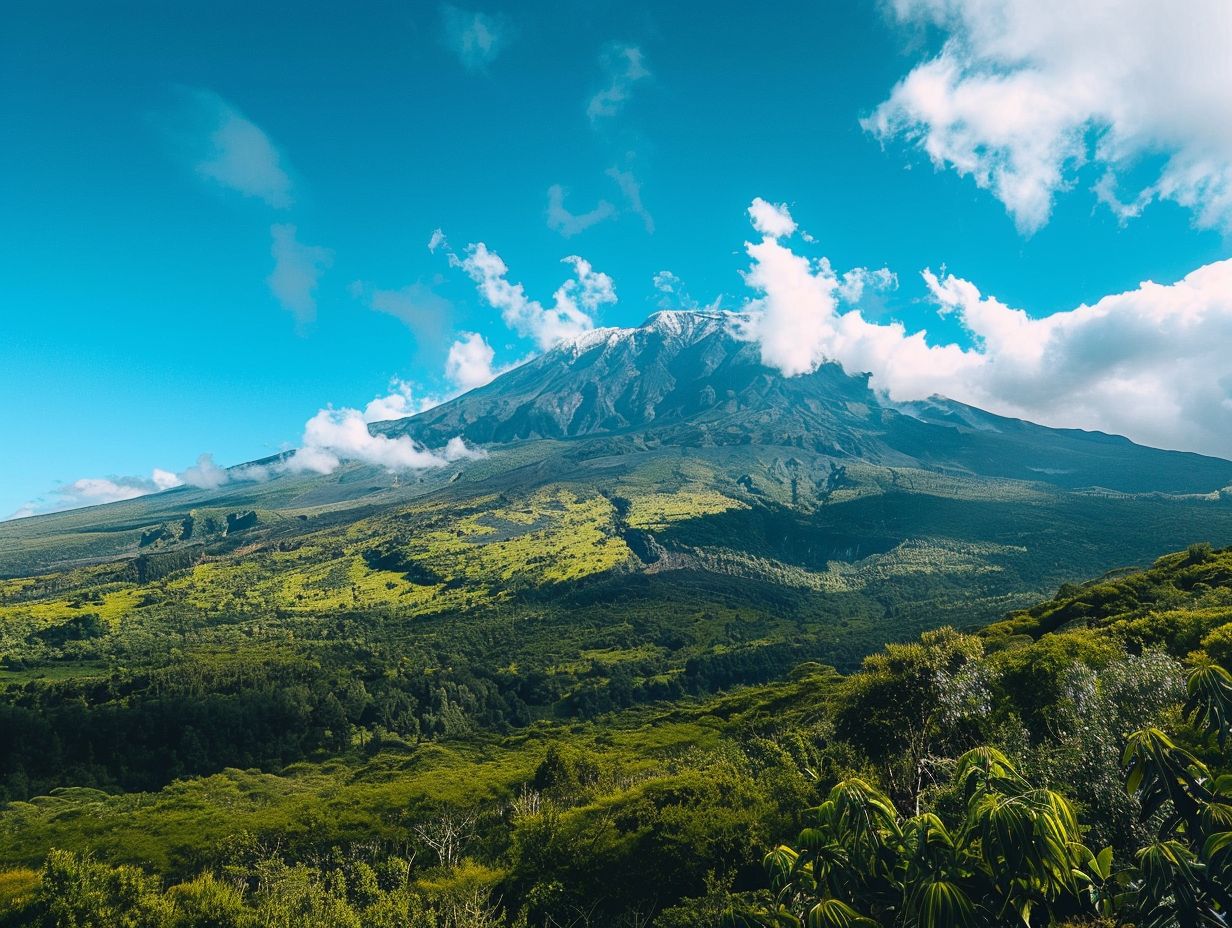
Mount Kilimanjaro, the highest peak in Africa, is a popular destination for adventure seekers and nature lovers alike.
Choosing the right route is crucial for a successful and enjoyable trek. Factors like difficulty level, scenery, crowds, cost, and accommodations all play a role in selecting the best route for your Kilimanjaro experience.
We compare the most popular Kilimanjaro routes, discuss the factors that can affect your success on the mountain, and provide recommendations to help you make the most of your journey to the top of Africa.
Key Takeaways:

- The Marangu route is the easiest but also the most crowded route on Kilimanjaro, known for its huts and gradual incline.
- The Machame route offers stunning views and a more challenging climb, with campsites and tents as accommodation options.
- For a longer and more scenic route, the Lemosho and Northern Circuit routes are recommended, with the highest success rates in reaching the summit.
Factors to Consider when Choosing a Kilimanjaro Route
When selecting a Kilimanjaro route, factors such as the level of difficulty, availability of accommodations like huts for resting, safety measures, personal preferences, and the importance of acclimatization play a crucial role in ensuring a successful expedition to the summit of Mount Kilimanjaro.
Choosing the right route involves a balance between personal comfort and safety. Safety measures vary between routes, with some being more challenging than others in terms of technical terrain and altitude gain. It’s imperative to assess your physical fitness and hiking experience before finalizing your choice. Proper acclimatization is key to preventing altitude sickness.
- Consider factors like weather conditions, elevation gain, and duration of the trek to match your fitness level and preferences.
- Consult with experienced guides or agencies for route recommendations based on your abilities and goals.
Exploring all these aspects will lead to a memorable and safe journey to the roof of Africa.
Difficulty Level
The difficulty level of a Kilimanjaro route is a critical factor that influences climbers’ success rates and their ability to acclimatize effectively to the altitude variations encountered during the ascent.
Each of the Kilimanjaro routes offers a unique challenge, with varying terrains, altitudes, and weather conditions. For instance, the Marangu route, known as the ‘Coca-Cola’ route due to its popularity, is considered one of the easier paths, featuring hut accommodations along the way. Its rapid ascent profile poses challenges for acclimatization.
In contrast, the Machame route, also called the ‘Whiskey’ route, is more scenic and offers better acclimatization opportunities due to its gradual ascent. This route is preferred by many climbers for its stunning views and higher success rates.
Scenery and Views
The Kilimanjaro routes offer mesmerizing scenery and breathtaking views that showcase the diverse landscapes, from lush wilderness to volcanic terrain, providing ample opportunities for photographers and nature enthusiasts to capture the beauty of the surroundings.
Each Kilimanjaro route boasts its own distinct charm and appeals to different preferences. For instance, the Machame route, known as the ‘Whiskey Route,’ unveils stunning rainforest scenery before transitioning into rocky landscapes and eventually reaching the iconic Uhuru Peak.
In contrast, the Marangu route, often termed the ‘Coca-Cola Route,’ features more gradual slopes and varied landscapes, offering glimpses of wildlife and colorful flora along the way.
Crowds and Traffic
The level of crowds and traffic on Kilimanjaro routes can significantly impact the overall experience, with popular routes often attracting more climbers and hikers, necessitating careful planning to ensure safety and enjoyment amidst the increasing popularity of the mountain.
When considering safety implications, the heavier footfall on well-known pathways, such as the Marangu and Machame trails, may lead to potential bottlenecks at crucial points, posing risks of delays and overcrowding during peak climbing seasons.
Amidst this bustling environment, climbers are advised to maintain a steady pace, stay hydrated, and be mindful of altitude sickness. Careful planning, including booking accommodations well in advance and opting for less crowded but equally scenic routes like the Lemosho or Rongai, can help mitigate the challenges posed by overcrowding.
Cost and Budget

The cost and budget considerations associated with climbing Kilimanjaro encompass expenses related to permits, accommodations, gear, and guides, making it essential for climbers to plan their financial resources wisely to ensure a well-prepared and comfortable expedition.
While the cost of climbing Kilimanjaro can vary depending on several factors such as the route chosen, the duration of the climb, and the level of support required, a major portion of the budget is typically allocated to the climbing permits, which are mandatory for all climbers.
Accommodation options range from basic campsites to more luxurious lodges, allowing climbers to choose based on their comfort preferences and budget constraints.
Guides and porters play a crucial role in ensuring the safety and success of the climb, and it’s essential to factor their fees into the overall budget.
Comparison of Kilimanjaro Routes
A comparative analysis of the Kilimanjaro routes, including Marangu, Machame, Lemosho, Rongai, and Northern Circuit, offers valuable insights into the unique characteristics, challenges, and scenic attractions that each route presents to climbers and hikers, enabling knowledge-based decision making based on individual preferences and trekking experience.
Marangu Route, often nicknamed the ‘Coca-Cola’ route due to its relative ease and popularity, provides comfortable hut accommodations along the way, offering a more structured trekking experience. On the other hand, the Machame Route, known as the ‘Whiskey’ route, boasts diverse landscapes from lush rainforests to stunning alpine deserts, providing a challenging yet rewarding journey.
Lemosho Route, recognized for its scenic beauty and gradual altitude acclimatization, takes climbers through varied terrain and offers magnificent views of the Shira Plateau. The Rongai Route, starting from the north side of the mountain, provides a more remote and less crowded trek, with stunning views of the Kenyan plains.
The Northern Circuit, the longest route, offers excellent acclimatization opportunities and panoramic views, making it a great choice for those seeking a less-traveled path with breathtaking scenery at each turn.
Marangu Route
The Marangu Route, often referred to as the ‘Coca-Cola’ route, stands out for its hut accommodations and relatively gradual ascent, culminating in the summit night push to Uhuru Peak, offering climbers a unique perspective on Mount Kilimanjaro’s southern face.
One of the key highlights of the Marangu Route is its hut accommodations, providing climbers with a more comfortable lodging option compared to camping. These huts offer basic amenities, such as beds and dining areas, making it a popular choice for those seeking a less rugged experience.
The summit night experience on the Marangu Route is both challenging and exhilarating. Climbers start their ascent in the early hours of the morning, navigating steep terrain and enduring the extreme weather conditions as they make their way towards the iconic Uhuru Peak.
As climbers progress towards Uhuru Peak, they are treated to breathtaking views of the surrounding landscapes, including the expansive glaciers that adorn the peak of Mount Kilimanjaro. The journey towards the summit is not just a physical challenge but also a spiritual and mental test of determination and perseverance.
Machame Route
The Machame Route, known for its scenic beauty and diverse landscapes, offers climbers an immersive camping experience amidst the picturesque surroundings, with challenging terrains and stunning views that make it a popular choice among adventurers seeking a rewarding Kilimanjaro climb.
Located on the southern slope of Mount Kilimanjaro, the Machame Route provides hikers with a variety of natural wonders to behold. From lush rainforests at lower altitudes to alpine deserts as you ascend higher, each segment of the journey unveils a different facet of this majestic mountain.
One of the remarkable features of this route is the camping facilities that dot the trail, offering a cozy retreat after a day of challenging trekking. Rest assured, climbers can relax and rejuvenate in the tranquility of these campsites, surrounded by the beauty of the Tanzanian wilderness.
Lemosho Route
The Lemosho Route stands out for its remote and wild ambiance, featuring expansive glaciers, lush wilderness, and panoramic views that captivate climbers with its pristine natural beauty, offering a challenging yet rewarding trekking experience on Mount Kilimanjaro.
Beginning at the western side of Mount Kilimanjaro, the Lemosho Route is considered one of the most scenic paths to the summit, allowing trekkers to witness the striking beauty of the Shira Plateau and the rugged terrain of the Southern Icefields.
Traversing through varying ecological zones, climbers are treated to a kaleidoscope of landscapes, from dense rainforests teeming with wildlife to alpine deserts dotted with otherworldly plant species.
The diversity of flora and fauna along the route adds an enchanting element to the journey, with opportunities to spot unique species such as the endemic Kilimanjaro tree hyrax or the colorful Jackson’s chameleon.
Rongai Route
The Rongai Route, renowned for its tranquility and wildlife sightings, offers climbers a unique trekking experience through diverse terrains, ensuring safety and serenity amidst the natural habitats and scenic beauty encountered along the expedition on Mount Kilimanjaro.
With its gradual slopes and well-maintained paths, this route appeals to both novice and experienced climbers seeking a less crowded and more peaceful journey up the mountain.
Mount Kilimanjaro’s northern side, where the Rongai Route lies, provides a refreshing escape from the hustle and bustle of the busier trails. As climbers ascend, they traverse through mesmerizing landscapes, from lush rainforests to alpine meadows, reveling in the diverse flora and fauna that call this region home.
Northern Circuit Route

The Northern Circuit Route, acclaimed for its gradual ascent and excellent acclimatization opportunities, leads climbers through diverse terrains and breathtaking landscapes, allowing for an enriching journey that prioritizes safety and acclimatization on the way to the summit of Mount Kilimanjaro.
The beauty of the Northern Circuit Route lies in its ability to offer climbers a unique experience of gradually adapting to the altitude and challenging conditions, ensuring a safer and more enjoyable climb. As climbers traverse through lush rainforests, alpine deserts, and arctic zones, they witness the ever-changing scenery and wildlife along the way.
The route’s longer duration allows for better acclimatization, reducing the risk of altitude-related illnesses. The carefully planned itinerary includes strategic rest days and gradual altitude gain, ensuring climbers adjust well to the changing conditions.
Factors that Affect Success on Kilimanjaro Routes
Several key factors influence the success of climbers on Kilimanjaro routes, including the management of altitude sickness, physical fitness levels, effective acclimatization strategies, and the impact of weather and climate conditions on the ascent to the summit.
Altitude sickness, often a challenging hurdle for climbers at high elevations, can cause symptoms like headaches, nausea, and fatigue, affecting both mental acuity and physical stamina essential for the arduous journey.
Maintaining optimal physical fitness is crucial, as the demanding terrain requires strength and endurance. Climbers must follow personalized training programs to prepare adequately for the expedition.
Strategic acclimatization techniques, such as gradual altitude gain and scheduled rest days, are vital to minimize the risk of altitude-related illnesses and improve overall summit success rates. Weather conditions, ranging from scorching sun to freezing temperatures, play a significant role in the climbing experience, demanding appropriate gear and preparation to navigate the diverse climates encountered on different Kilimanjaro routes.
Altitude Sickness
Altitude sickness poses a significant challenge for climbers on Kilimanjaro routes, requiring careful acclimatization, hydration, and awareness of symptoms to mitigate risks and ensure the safety and well-being of individuals during the ascent.
Altitude sickness, also known as acute mountain sickness (AMS), can occur when ascending to high altitudes too quickly, leading to a decrease in oxygen levels in the body. The management of altitude sickness on Kilimanjaro climbs involves a systematic approach to acclimatization, where climbers gradually ascend with planned rest days to allow their bodies to adjust to the reduced oxygen pressure.
It is vital to monitor symptoms such as headaches, fatigue, nausea, and dizziness closely as early recognition can prevent the condition from worsening.
Physical Fitness
Physical fitness plays a crucial role in determining climbers’ success rates on Kilimanjaro routes, with endurance, strength, and stamina being essential attributes that contribute to an enjoyable and safe trekking experience amidst the mountain’s challenging terrains and altitudes.
Amongst the diverse routes leading to Kilimanjaro’s summit, climbers face a range of physical challenges that require peak fitness levels. The grueling ascents, varying altitudes, and unpredictable weather conditions demand a strong body and mind to persevere through the journey.
Climbers with exceptional endurance can sustain the prolonged periods of strenuous activity involved in conquering the mountain. Muscular strength and robust stamina are crucial for navigating rocky paths, carrying equipment, and withstanding the effects of high altitudes on the body.
Acclimatization
Effective acclimatization strategies are paramount for climbers on Kilimanjaro routes to adapt to high altitudes gradually, mitigate altitude-related risks, and enhance their safety and chances of summiting successfully.
Acclimatization involves the process through which the body adjusts to decreasing oxygen levels at higher altitudes, allowing climbers to cope with the physiological challenges they face while ascending.
This gradual adjustment not only reduces the likelihood of altitude sickness, such as headache, nausea, and fatigue, but also improves oxygen uptake and circulation, thereby increasing energy levels and cognitive function.
Climbers who follow structured acclimatization routines, including proper hydration, gradual ascent, and rest days at different altitudes, tend to have a significantly higher success rate in reaching the Uhuru Peak, the highest point of Kilimanjaro.
Weather and Climate
The weather and climate conditions on Kilimanjaro significantly impact climbers’ safety, comfort, and success rates, with unpredictable changes in weather patterns necessitating careful planning, gear preparation, and awareness to navigate the mountain’s diverse climatic zones effectively.
Weather variations on Kilimanjaro can range from scorching heat to freezing temperatures in a span of a few hours, challenging even the most seasoned climbers. Climbers must be equipped with appropriate gear to handle these extremes, including layered clothing, sturdy boots, and high-quality sleeping bags.
Monitoring weather forecasts is crucial, as sudden storms or whiteout conditions can abruptly alter the course of an expedition. Understanding how weather and climate dynamics affect the body’s performance at high altitudes is key to achieving a successful summit.”
Conclusion and Recommendations

Selecting the right Kilimanjaro route tailored to your preferences, physical fitness, budget, and safety considerations is crucial for optimizing your chances of a successful summit attempt, enriching trekking experience amidst stunning landscapes, and creating lasting memories of your adventure on Africa’s tallest mountain.
In terms of Kilimanjaro routes, each option offers unique challenges and highlights. For instance, the Lemosho route is known for its scenic beauty and gradual ascent, making it a favorite among many climbers.
On the other hand, the Machame route, though more popular, involves steeper paths but allows for better acclimatization. Considering factors like altitude sickness prevention, route difficulty, and duration are key in making an informed choice.
Your safety should always be a top priority, so ensure your route selection aligns with your physical capabilities and experience level.
Final Thoughts and Recommendations
As you embark on your Kilimanjaro journey, remember to prioritize safety, acclimatization, and proper planning to enhance your chances of a successful summit. Consider the best time to climb based on weather conditions, crowd levels, and personal preferences for a rewarding and memorable experience on the majestic Mount Kilimanjaro.
Being the highest free-standing mountain in the world, Mount Kilimanjaro presents a unique challenge due to its varying climatic zones and altitudes. It is vital to acclimatize properly to combat altitude sickness and ensure a smooth ascent. Pack essential items such as warm clothing, sturdy footwear, and high-energy snacks to stay comfortable and energized throughout the trek.
Booking your climb through reputable tour operators with experienced guides and support staff can significantly enhance your safety and overall experience. Take the time to train physically before the climb to build endurance and strength, and familiarize yourself with the route to make informed decisions during the journey.
Frequently Asked Questions
What is considered the best Kilimanjaro route?
The best Kilimanjaro route depends on various factors such as fitness level, experience, and personal preferences. However, the Machame Route is often considered the best route due to its scenic views and high success rate.
Is the Machame Route suitable for beginners?
Yes, the Machame Route is suitable for beginners as it provides a gradual ascent and allows for proper acclimatization. However, it is still important to have a good level of fitness and to train prior to the climb.
Which route has the highest success rate?
The Marangu Route has the highest success rate due to its shorter duration and easier terrain. However, the success rate can also be influenced by personal factors such as fitness and acclimatization.
What makes the Lemosho Route unique?
The Lemosho Route is the longest route on Kilimanjaro and provides a more remote and scenic experience. It also has a high success rate and allows for better acclimatization due to its longer duration.
Are there any routes that are less crowded?
The Rongai Route is often considered the least crowded route as it approaches Kilimanjaro from the north and has fewer trekkers compared to other routes. It also offers a more unique perspective of the mountain.
Which route offers the most challenging climb?
The Umbwe Route is the most challenging route on Kilimanjaro as it is steeper and has a shorter duration, providing less time for acclimatization. It is recommended only for experienced trekkers with a high level of fitness.